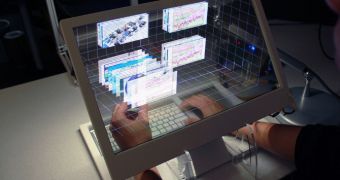Every once in a while, a project will be published that can turn the world on its head, or at least open up new doors to how we interact with technology. The transparent 3D PC from MIT is one such project.
Jinha Lee, an interaction researcher and PhD candidate at MIT, has created what he dubs a “see-through 3D desktop.”
It is an internship project done under the guidance of Cati Boulanger during June-September 2011, at Microsoft Applied Sciences Group. It is a precursor to SpaceTop.
The transparent display is the first essential component of the PC. The second is a set of cameras, one of which is set on the screen and the others above the keyboard.
The keyboard itself has a track-pad and is also located behind the screen.
Together, all these components allow users to reach in and grab windows or slides, or anything else arranged in the 3D environment, and move them around.
The user basically gets a holographic view that adapts to his or her point of view, and can be operated by hand, in 3D.
The technology is still rough around the edges, with the prototype showing delays in response, but the potential applications are nearly limitless, and there is no denying of the “coolness” factor.
“See-through 3D desktop is a term for the entire ensemble of necessary software hardware and design technological components for realizing this volumetric operating environment,” Jinha Lee explains.
“A unique combination of a transparent display and 3D gesture detection algorithm collocates input space and 3D rendering without tethering or encumbering users with wearable devices.”
The SpaceTop 3D Desktop Computer, based on the see-through 3D desktop, will allow for seamless transition from 2D to 3D (and back) and even let 3D manipulations be done at the same time as typing, clicking and drawing in 2D.

 14 DAY TRIAL //
14 DAY TRIAL // 